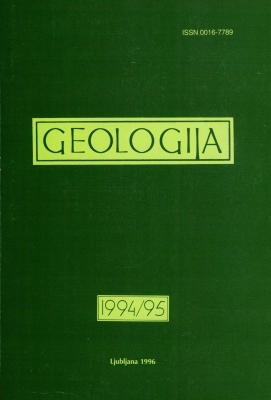Modeliranje refleksijskih seizmičnih podatkov za podzemno skladiščenje plina v strukturah Pečarovci in Dankovci - Murska depresija
DOI:
https://doi.org/10.5474/geologija.1995.019Povzetek
Antiformni strukturi Pečarovci in Dankovci v Murski depresiji sta bili izbrani kot najprimernejši v Sloveniji za gradnjo podzemnega skladišča plina v vodonosniku. Da bi dokazali velikost in zaprtost struktur, je bilo posnetih 17 refleksijskih seizmičnih profilov v skupni dolžini 157km in izvrtane so bile tri vrtine. S programom Sierra Mimic je bil izdelan strukturni model dveh interpretiranih horizontov (mezozojska podlaga terciarnih kamnin in meja badenij-sarmatij). Vrednotenje različnih hitrostnih podatkov (analiza hitrosti, akustična karotaža, meritve seizmičnih hitrosti v vrtinah in laboratorijsko na jedrih) je omogočilo natančno spremembo časa v globino ter ugotovitev bočnih sprememb hitrosti. Primerjava ročno in računalniško konstruiranih kart je pokazala dobro ujemanje, z nekoliko večjim odstopanjem le na SE strani strukture Pečarovci. Porozno plast predstavlja v tej strukturi 70m debela plast dolomita v globini 1900m, neprepustno krovnino pa več sto metrov debele plasti laporja. Struktura Dankovci v globini 1200m, kjer predstavljajo ustrezne porozne kamnine tanke plasti konglomerata in peščenjaka, je bila zaradi prelomov ocenjena za manj primerno. Z ID sintetičnimi seizmogrami je bila opravljena korelacija geoloških in seizmičnih podatkov v vrtinah, posebno na intervalih s tankimi plastmi. Metoda sledenja žarkov na 2D modelih (programski paket Sierra Quik) je bila uporabljena za ugotavljanje zveznosti nekaterih horizontov in za ugotavljanje obstoja prelomov, ki so pomemben dejavnik za skladiščenje plina.Prenosi
Kako citirati
Gosar, A. (1994). Modeliranje refleksijskih seizmičnih podatkov za podzemno skladiščenje plina v strukturah Pečarovci in Dankovci - Murska depresija . Geologija, 37(1), 483–549. https://doi.org/10.5474/geologija.1995.019
Številka
Rubrika
Članki

